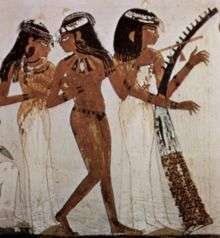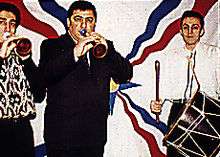Music
Music is an art form, and cultural activity, whose medium is sound. General definitions of music include common elements such as pitch (which governs melody and harmony), rhythm (and its associated concepts tempo, meter, and articulation), dynamics (loudness and softness), and the sonic qualities of timbre and texture (which are sometimes termed the "color" of a musical sound). Different styles or types of music may emphasize, de-emphasize or omit some of these elements. Music is performed with a vast range of instruments and vocal techniques ranging from singing to rapping; there are solely instrumental pieces, solely vocal pieces (such as songs without instrumental accompaniment) and pieces that combine singing and instruments. The word derives from Greek μουσική (mousike; "art of the Muses").[1] See glossary of musical terminology.
| Music | |
|---|---|
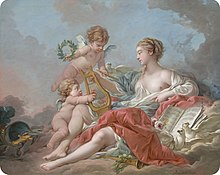 Allegot of Music, by François Boucher, from 1764 | |
| Medium | Sound, silence, time |
| Originating culture | Various |
| Originating era | Paleolithic era |
| Performing arts |
|---|
In its most general form, the activities describing music as an art form or cultural activity include the creation of works of music (songs, tunes, symphonies, and so on), the criticism of music, the study of the history of music, and the aesthetic examination of music. Ancient Greek and Indian philosophers defined music in two parts: melodies, as tones ordered horizontally, and harmonies as tones ordered vertically. Common sayings such as "the harmony of the spheres" and "it is music to my ears" point to the notion that music is often ordered and pleasant to listen to. However, 20th-century composer John Cage thought that any sound can be music, saying, for example, "There is no noise, only sound."[2]
The creation, performance, significance, and even the definition of music vary according to culture and social context. Indeed, throughout history, some new forms or styles of music have been criticized as "not being music", including Beethoven's Grosse Fuge string quartet in 1825,[3] early jazz in the beginning of the 1900s[4] and hardcore punk in the 1980s.[5] There are many types of music, including popular music, traditional music, art music, music written for religious ceremonies and work songs such as chanteys. Music ranges from strictly organized compositions—such as Classical music symphonies from the 1700s and 1800s—through to spontaneously played improvisational music such as jazz, and avant-garde styles of chance-based contemporary music from the 20th and 21st centuries.
Music can be divided into genres (e.g., country music) and genres can be further divided into subgenres (e.g., country blues and pop country are two of the many country subgenres), although the dividing lines and relationships between music genres are often subtle, sometimes open to personal interpretation, and occasionally controversial. For example, it can be hard to draw the line between some early 1980s hard rock and heavy metal. Within the arts, music may be classified as a performing art, a fine art or as an auditory art. Music may be played or sung and heard live at a rock concert or orchestra performance, heard live as part of a dramatic work (a music theater show or opera), or it may be recorded and listened to on a radio, MP3 player, CD player, smartphone or as film score or TV show.
In many cultures, music is an important part of people's way of life, as it plays a key role in religious rituals, rite of passage ceremonies (e.g., graduation and marriage), social activities (e.g., dancing) and cultural activities ranging from amateur karaoke singing to playing in an amateur funk band or singing in a community choir. People may make music as a hobby, like a teen playing cello in a youth orchestra, or work as a professional musician or singer. The music industry includes the individuals who create new songs and musical pieces (such as songwriters and composers), individuals who perform music (which include orchestra, jazz band and rock band musicians, singers and conductors), individuals who record music (music producers and sound engineers), individuals who organize concert tours, and individuals who sell recordings, sheet music, and scores to customers. Even once a song or piece has been performed, music critics, music journalists, and music scholars may assess and evaluate the piece and its performance.
Etymology
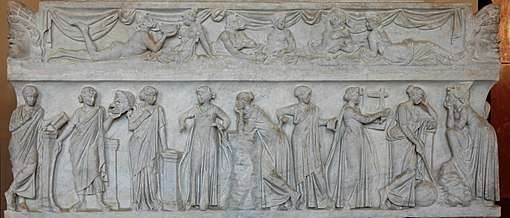
The word derives from Greek μουσική (mousike; "art of the Muses").[1] In Greek mythology, the nine Muses were the goddesses who inspired literature, science, and the arts and who were the source of the knowledge embodied in the poetry, song-lyrics, and myths in the Greek culture. According to the Online Etymological Dictionary, the term "music" is derived from "mid-13c., musike, from Old French musique (12c.) and directly from Latin musica "the art of music," also including poetry (also [the] source of Spanish música, Italian musica, Old High German mosica, German Musik, Dutch muziek, Danish musik)." This is derived from the "...Greek mousike (techne) "(art) of the Muses," from fem. of mousikos "pertaining to the Muses," from Mousa "Muse" (see muse (n.)). Modern spelling [dates] from [the] 1630s. In classical Greece, [the term "music" refers to] any art in which the Muses presided, but especially music and lyric poetry."[6]
As a form of art or entertainment
Music is composed and performed for many purposes, ranging from aesthetic pleasure, religious or ceremonial purposes, or as an entertainment product for the marketplace. When music was only available through sheet music scores, such as during the Classical and Romantic eras, music lovers would buy the sheet music of their favourite pieces and songs so that they could perform them at home on the piano. With the advent of the phonograph, records of popular songs, rather than sheet music became the dominant way that music lovers would enjoy their favourite songs. With the advent of home tape recorders in the 1980s and digital music in the 1990s, music lovers could make tapes or playlists of their favourite songs and take them with them on a portable cassette player or MP3 player. Some music lovers create mix tapes of their favourite songs, which serve as a "self-portrait, a gesture of friendship, prescription for an ideal party... [and] an environment consisting solely of what is most ardently loved."[7]
Amateur musicians can compose or perform music for their own pleasure, and derive their income elsewhere. Professional musicians are employed by a range of institutions and organisations, including armed forces (in marching bands, concert bands and popular music groups), churches and synagogues, symphony orchestras, broadcasting or film production companies, and music schools. Professional musicians sometimes work as freelancers or session musicians, seeking contracts and engagements in a variety of settings. There are often many links between amateur and professional musicians. Beginning amateur musicians take lessons with professional musicians. In community settings, advanced amateur musicians perform with professional musicians in a variety of ensembles such as community concert bands and community orchestras.
A distinction is often made between music performed for a live audience and music that is performed in a studio so that it can be recorded and distributed through the music retail system or the broadcasting system. However, there are also many cases where a live performance in front of an audience is also recorded and distributed. Live concert recordings are popular in both classical music and in popular music forms such as rock, where illegally taped live concerts are prized by music lovers. In the jam band scene, live, improvised jam sessions are preferred to studio recordings.
Composition
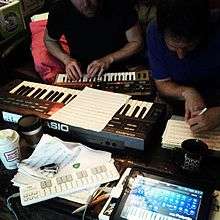

"Composition" is the act or practice of creating a song, an instrumental music piece, a work with both singing and instruments, or another type of music. In many cultures, including Western classical music, the act of composing also includes the creation of music notation, such as a sheet music "score", which is then performed by the composer or by other singers or musicians. In popular music and traditional music, the act of composing, which is typically called songwriting, may involve the creation of a basic outline of the song, called the lead sheet, which sets out the melody, lyrics and chord progression. In classical music, the composer typically orchestrates his or her own compositions, but in musical theatre and in pop music, songwriters may hire an arranger to do the orchestration. In some cases, a songwriter may not use notation at all, and instead compose the song in her mind and then play or record it from memory. In jazz and popular music, notable recordings by influential performers are given the weight that written scores play in classical music.
Even when music is notated relatively precisely, as in classical music, there are many decisions that a performer has to make, because notation does not specify all of the elements of music precisely. The process of deciding how to perform music that has been previously composed and notated is termed "interpretation". Different performers' interpretations of the same work of music can vary widely, in terms of the tempos that are chosen and the playing or singing style or phrasing of the melodies. Composers and songwriters who present their own music are interpreting their songs, just as much as those who perform the music of others. The standard body of choices and techniques present at a given time and a given place is referred to as performance practice, whereas interpretation is generally used to mean the individual choices of a performer.
Although a musical composition often uses musical notation and has a single author, this is not always the case. A work of music can have multiple composers, which often occurs in popular music when a band collaborates to write a song, or in musical theatre, when one person writes the melodies, a second person writes the lyrics, and a third person orchestrates the songs. In some styles of music, such as the blues, a composer/songwriter may create, perform and record new songs or pieces without ever writing them down in music notation. A piece of music can also be composed with words, images, or computer programs that explain or notate how the singer or musician should create musical sounds. Examples range from avant-garde music that uses graphic notation, to text compositions such as Aus den sieben Tagen, to computer programs that select sounds for musical pieces. Music that makes heavy use of randomness and chance is called aleatoric music, and is associated with contemporary composers active in the 20th century, such as John Cage, Morton Feldman, and Witold Lutosławski. A more commonly known example of chance-based music is the sound of wind chimes jingling in a breeze.
The study of composition has traditionally been dominated by examination of methods and practice of Western classical music, but the definition of composition is broad enough to include the creation of popular music and traditional music songs and instrumental pieces as well as spontaneously improvised works like those of free jazz performers and African percussionists such as Ewe drummers.
Notation

In the 2000s, music notation typically means the written expression of music notes and rhythms on paper using symbols. When music is written down, the pitches and rhythm of the music, such as the notes of a melody, are notated. Music notation also often provides instructions on how to perform the music. For example, the sheet music for a song may state that the song is a "slow blues" or a "fast swing", which indicates the tempo and the genre. To read music notation, a person must have an understanding of music theory, harmony and the performance practice associated with a particular song or piece's genre.
Written notation varies with style and period of music. In the 2000s, notated music is produced as sheet music or, for individuals with computer scorewriter programs, as an image on a computer screen. In ancient times, music notation was put onto stone or clay tablets. To perform music from notation, a singer or instrumentalist requires an understanding of the rhythmic and pitch elements embodied in the symbols and the performance practice that is associated with a piece of music or a genre. In genres requiring musical improvisation, the performer often plays from music where only the chord changes and form of the song are written, requiring the performer to have a great understanding of the music's structure, harmony and the styles of a particular genre (e.g., jazz or country music).
In Western art music, the most common types of written notation are scores, which include all the music parts of an ensemble piece, and parts, which are the music notation for the individual performers or singers. In popular music, jazz, and blues, the standard musical notation is the lead sheet, which notates the melody, chords, lyrics (if it is a vocal piece), and structure of the music. Fake books are also used in jazz; they may consist of lead sheets or simply chord charts, which permit rhythm section members to improvise an accompaniment part to jazz songs. Scores and parts are also used in popular music and jazz, particularly in large ensembles such as jazz "big bands." In popular music, guitarists and electric bass players often read music notated in tablature (often abbreviated as "tab"), which indicates the location of the notes to be played on the instrument using a diagram of the guitar or bass fingerboard. Tablature was also used in the Baroque era to notate music for the lute, a stringed, fretted instrument.
Improvisation
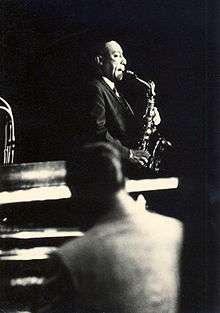
Musical improvisation is the creation of spontaneous music, often within (or based on) a pre-existing harmonic framework or chord progression. Improvisers use the notes of the chord, various scales that are associated with each chord, and chromatic ornaments and passing tones which may be neither chord tones not from the typical scales associated with a chord. Musical improvisation can be done with or without preparation. Improvisation is a major part of some types of music, such as blues, jazz, and jazz fusion, in which instrumental performers improvise solos, melody lines and accompaniment parts.
In the Western art music tradition, improvisation was an important skill during the Baroque era and during the Classical era. In the Baroque era, performers improvised ornaments, and basso continuo keyboard players improvised chord voicings based on figured bass notation. As well, the top soloists were expected to be able to improvise pieces such as preludes. In the Classical era, solo performers and singers improvised virtuoso cadenzas during concerts.
However, in the 20th and early 21st century, as "common practice" Western art music performance became institutionalized in symphony orchestras, opera houses and ballets, improvisation has played a smaller role, as more and more music was notated in scores and parts for musicians to play. At the same time, some 20th and 21st century art music composers have increasingly included improvisation in their creative work. In Indian classical music, improvisation is a core component and an essential criterion of performances.
Theory
Music theory encompasses the nature and mechanics of music. It often involves identifying patterns that govern composers' techniques and examining the language and notation of music. In a grand sense, music theory distills and analyzes the parameters or elements of music – rhythm, harmony (harmonic function), melody, structure, form, and texture. Broadly, music theory may include any statement, belief, or conception of or about music.[8] People who study these properties are known as music theorists, and they typically work as professors in colleges, universities, and music conservatories. Some have applied acoustics, human physiology, and psychology to the explanation of how and why music is perceived. Music theorists publish their research in music theory journals and university press books.
Elements
Music has many different fundamentals or elements. Depending on the definition of "element" being used, these can include: pitch, beat or pulse, tempo, rhythm, melody, harmony, texture, style, allocation of voices, timbre or color, dynamics, expression, articulation, form and structure. The elements of music feature prominently in the music curriculums of Australia, UK and US. All three curriculums identify pitch, dynamics, timbre and texture as elements, but the other identified elements of music are far from universally agreed. Below is a list of the three official versions of the "elements of music":
- Australia: pitch, timbre, texture, dynamics and expression, rhythm, form and structure.[9]
- UK: pitch, timbre, texture, dynamics, duration, tempo, structure.[10]
- USA: pitch, timbre, texture, dynamics, rhythm, form, harmony, style/articulation.[11]
In relation to the UK curriculum, in 2013 the term: "appropriate musical notations" was added to their list of elements and the title of the list was changed from the "elements of music" to the "inter-related dimensions of music". The inter-related dimensions of music are listed as: pitch, duration, dynamics, tempo, timbre, texture, structure and appropriate musical notations.[12]
The phrase "the elements of music" is used in a number of different contexts. The two most common contexts can be differentiated by describing them as the "rudimentary elements of music" and the "perceptual elements of music".
Rudimentary elements
In the 1800s, the phrases "the elements of music" and "the rudiments of music" were used interchangeably.[13][14] The elements described in these documents refer to aspects of music that are needed in order to become a musician, Recent writers such as Espie Estrella seem to be using the phrase "elements of music" in a similar manner.[15] A definition which most accurately reflects this usage is: "the rudimentary principles of an art, science, etc.: the elements of grammar."[16] The UK's curriculum switch to the "inter-related dimensions of music" seems to be a move back to using the rudimentary elements of music.
Perceptual elements
Since the emergence of the study of psychoacoustics in the 1930s, most lists of elements of music have related more to how we hear music than how we learn to play it or study it. C.E. Seashore, in his book Psychology of Music,[17] identified four "psychological attributes of sound". These were: "pitch, loudness, time, and timbre" (p. 3). He did not call them the "elements of music" but referred to them as "elemental components" (p. 2). Nonetheless these elemental components link precisely with four of the most common musical elements: "Pitch" and "timbre" match exactly, "loudness" links with dynamics and "time" links with the time-based elements of rhythm, duration and tempo. This usage of the phrase "the elements of music" links more closely with Webster's New 20th Century Dictionary definition of an element as: "a substance which cannot be divided into a simpler form by known methods"[18] and educational institutions' lists of elements generally align with this definition as well.
Although writers of lists of "rudimentary elements of music" can vary their lists depending on their personal (or institutional) priorities, the perceptual elements of music should consist of an established (or proven) list of discrete elements which can be independently manipulated to achieve an intended musical effect. It seems at this stage that there is still research to be done in this area.
A slightly different way of approaching the identification of the elements of music, is to identify the "elements of sound" as: pitch, duration, loudness, timbre, sonic texture and spatial location,[19] and then to define the "elements of music" as: sound, structure, and artistic intent.[20]
Description of elements
Pitch and melody
Pitch is an aspect of a sound that we can hear, reflecting whether one musical sound, note or tone is "higher" or "lower" than another musical sound, note or tone. We can talk about the highness or lowness of pitch in the more general sense, such as the way a listener hears a piercingly high piccolo note or whistling tone as higher in pitch than a deep thump of a bass drum. We also talk about pitch in the precise sense associated with musical melodies, basslines and chords. Precise pitch can only be determined in sounds that have a frequency that is clear and stable enough to distinguish from noise. For example, it is much easier for listeners to discern the pitch of a single note played on a piano than to try to discern the pitch of a crash cymbal that is struck.

A melody (also called a "tune") is a series of pitches (notes) sounding in succession (one after the other), often in a rising and falling pattern. The notes of a melody are typically created using pitch systems such as scales or modes. Melodies also often contain notes from the chords used in the song. The melodies in simple folk songs and traditional songs may use only the notes of a single scale, the scale associated with the tonic note or key of a given song. For example, a folk song in the key of C (also referred to as C major) may have a melody that uses only the notes of the C major scale (the individual notes C, D, E, F, G, A, B and C; these are the "white notes" on a piano keyboard. On the other hand, Bebop-era jazz from the 1940s and contemporary music from the 20th and 21st centuries may use melodies with many chromatic notes (i.e., notes in addition to the notes of the major scale; on a piano, a chromatic scale would include all the notes on the keyboard, including the "white notes" and "black notes" and unusual scales, such as the whole tone scale (a whole tone scale in the key of C would contain the notes C, D, E, F♯, G♯ and A♯). A low, deep musical line played by bass instruments such as double bass, electric bass or tuba is called a bassline.
Harmony and chords
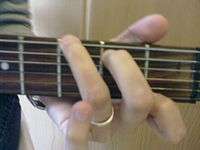
Harmony refers to the "vertical" sounds of pitches in music, which means pitches that are played or sung together at the same time to create a chord. Usually this means the notes are played at the same time, although harmony may also be implied by a melody that outlines a harmonic structure (i.e., by using melody notes that are played one after the other, outlining the notes of a chord). In music written using the system of major-minor tonality ("keys"), which includes most classical music written from 1600 to 1900 and most Western pop, rock and traditional music, the key of a piece determines the scale used, which centres around the "home note" or tonic of the key. Simple classical pieces and many pop and traditional music songs are written so that all the music is in a single key. More complex Classical, pop and traditional music songs and pieces may have two keys (and in some cases three or more keys). Classical music from the Romantic era (written from about 1820–1900) often contains multiple keys, as does jazz, especially Bebop jazz from the 1940s, in which the key or "home note" of a song may change every four bars or even every two bars.
Rhythm
Rhythm is the arrangement of sounds and silences in time. Meter animates time in regular pulse groupings, called measures or bars, which in Western classical, popular and traditional music often group notes in sets of two (e.g., 2/4 time), three (e.g., 3/4 time, also known as Waltz time, or 3/8 time), or four (e.g., 4/4 time). Meters are made easier to hear because songs and pieces often (but not always) place an emphasis on the first beat of each grouping. Notable exceptions exist, such as the backbeat used in much Western pop and rock, in which a song that uses a measure that consists of four beats (called 4/4 time or common time) will have accents on beats two and four, which are typically performed by the drummer on the snare drum, a loud and distinctive-sounding percussion instrument. In pop and rock, the rhythm parts of a song are played by the rhythm section, which includes chord-playing instruments (e.g., electric guitar, acoustic guitar, piano, or other keyboard instruments), a bass instrument (typically electric bass or for some styles such as jazz and bluegrass, double bass) and a drum kit player.
Texture
Musical texture is the overall sound of a piece of music or song. The texture of a piece or song is determined by how the melodic, rhythmic, and harmonic materials are combined in a composition, thus determining the overall nature of the sound in a piece. Texture is often described in regard to the density, or thickness, and range, or width, between lowest and highest pitches, in relative terms as well as more specifically distinguished according to the number of voices, or parts, and the relationship between these voices (see common types below). For example, a thick texture contains many 'layers' of instruments. One of these layers could be a string section, or another brass. The thickness also is affected by the amount and the richness of the instruments. Texture is commonly described according to the number of and relationship between parts or lines of music:
- monophony: a single melody (or "tune") with neither instrumental accompaniment nor a harmony part. A mother singing a lullaby to her baby would be an example.
- heterophony: two or more instruments or singers playing/singing the same melody, but with each performer slightly varying the rhythm or speed of the melody or adding different ornaments to the melody. Two bluegrass fiddlers playing the same traditional fiddle tune together will typically each vary the melody a bit and each add different ornaments.
- polyphony: multiple independent melody lines that interweave together, which are sung or played at the same time. Choral music written in the Renaissance music era was typically written in this style. A round, which is a song such as "Row, Row, Row Your Boat", which different groups of singers all start to sing at a different time, is a simple example of polyphony.
- homophony: a clear melody supported by chordal accompaniment. Most Western popular music songs from the 19th century onward are written in this texture.
Music that contains a large number of independent parts (e.g., a double concerto accompanied by 100 orchestral instruments with many interweaving melodic lines) is generally said to have a "thicker" or "denser" texture than a work with few parts (e.g., a solo flute melody accompanied by a single cello).
Timbre or "tone color"
Timbre, sometimes called "color" or "tone color" is the quality or sound of a voice or instrument.[21] Timbre is what makes a particular musical sound different from another, even when they have the same pitch and loudness. For example, a 440 Hz A note sounds different when it is played on oboe, piano, violin or electric guitar. Even if different players of the same instrument play the same note, their notes might sound different due to differences in instrumental technique (e.g., different embouchures), different types of accessories (e.g., mouthpieces for brass players, reeds for oboe and bassoon players) or strings made out of different materials for string players (e.g., gut strings versus steel strings). Even two instrumentalists playing the same note on the same instrument (one after the other) may sound different due to different ways of playing the instrument (e.g., two string players might hold the bow differently).
The physical characteristics of sound that determine the perception of timbre include the spectrum, envelope and overtones of a note or musical sound. For electric instruments developed in the 20th century, such as electric guitar, electric bass and electric piano, the performer can also change the tone by adjusting equalizer controls, tone controls on the instrument, and by using electronic effects units such as distortion pedals. The tone of the electric Hammond organ is controlled by adjusting drawbars.
Expression
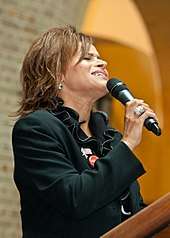
Expressive qualities are those elements in music that create change in music without changing the main pitches or substantially changing the rhythms of the melody and its accompaniment. Performers, including singers and instrumentalists, can add musical expression to a song or piece by adding phrasing, by adding effects such as vibrato (with voice and some instruments, such as guitar, violin, brass instruments and woodwinds), dynamics (the loudness or softness of piece or a section of it), tempo fluctuations (e.g., ritardando or accelerando, which are, respectively slowing down and speeding up the tempo), by adding pauses or fermatas on a cadence, and by changing the articulation of the notes (e.g., making notes more pronounced or accented, by making notes more legato, which means smoothly connected, or by making notes shorter).
Expression is achieved through the manipulation of pitch (such as inflection, vibrato, slides etc.), volume (dynamics, accent, tremolo etc.), duration (tempo fluctuations, rhythmic changes, changing note duration such as with legato and staccato, etc.), timbre (e.g. changing vocal timbre from a light to a resonant voice) and sometimes even texture (e.g. doubling the bass note for a richer effect in a piano piece). Expression therefore can be seen as a manipulation of all elements in order to convey "an indication of mood, spirit, character etc." [22] and as such cannot be included as a unique perceptual element of music,[23] although it can be considered an important rudimentary element of music.
Form
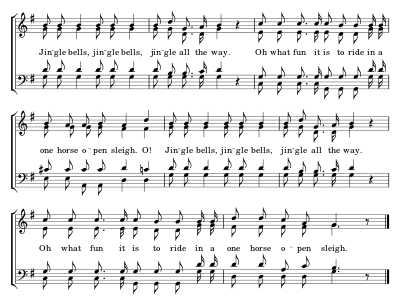
In music, form describes the overall structure or plan of a song or piece of music,[24] and it describes the layout of a composition as divided into sections.[25] In the early 20th century, Tin Pan Alley songs and Broadway musical songs were often in AABA 32 bar form, in which the A sections repeated the same eight bar melody (with variation) and the B section provided a contrasting melody or harmony for eight bars. From the 1960s onward, Western pop and rock songs are often in verse-chorus form, which is based around a sequence of verse and chorus ("refrain") sections, with new lyrics for most verses and repeating lyrics for the choruses. Popular music often makes use of strophic form, sometimes in conjunction with the twelve bar blues.
In the tenth edition of The Oxford Companion to Music, Percy Scholes defines musical form as "a series of strategies designed to find a successful mean between the opposite extremes of unrelieved repetition and unrelieved alteration."[26] Examples of common forms of Western music include the fugue, the invention, sonata-allegro, canon, strophic, theme and variations, and rondo.
Scholes states that European classical music had only six stand-alone forms: simple binary, simple ternary, compound binary, rondo, air with variations, and fugue (although musicologist Alfred Mann emphasized that the fugue is primarily a method of composition that has sometimes taken on certain structural conventions.[27])
Where a piece cannot readily be broken down into sectional units (though it might borrow some form from a poem, story or programme), it is said to be through-composed. Such is often the case with a fantasia, prelude, rhapsody, etude (or study), symphonic poem, Bagatelle, impromptu, etc. Professor Charles Keil classified forms and formal detail as "sectional, developmental, or variational."[28]
- Sectional form
- This form is built from a sequence of clear-cut units[29] that may be referred to by letters but also often have generic names such as introduction and coda, exposition, development and recapitulation, verse, chorus or refrain, and bridge. Introductions and codas, when they are no more than that, are frequently excluded from formal analysis. All such units may typically be eight measures long. Sectional forms include:
- Strophic form
- This form is defined by its "unrelieved repetition" (AAAA...)
- Medley
- Medley, potpourri is the extreme opposite, that of "unrelieved variation": it is simply an indefinite sequence of self-contained sections (ABCD...), sometimes with repeats (AABBCCDD...) Examples include orchestral overtures, which are sometimes no more than a string of the best tunes of the musical theatre show or opera to come.

- Binary form
- This form uses two sections (AB...), each often repeated (AABB...) In 18th-century Western classical music, "simple binary" form was often used for dances and carried with it the convention that the two sections should be in different musical keys but same rhythm, duration and tone. The alternation of two tunes gives enough variety to permit a dance to be extended for as long as desired.
- Ternary form
- This form has three parts. In Western classical music a simple ternary form has a third section that is a recapitulation of the first (ABA). Often, the first section is repeated (AABA). This approach was popular in the 18th-century operatic aria,[31] and was called da capo (i.e. "repeat from the top") form. Later, it gave rise to the 32-bar song, with the B section then often referred to as the "middle eight". A song has more need than a dance of a self-contained form with a beginning and an end of course.
- Rondo form
- This form has a recurring theme alternating with different (usually contrasting) sections called "episodes". It may be asymmetrical (ABACADAEA) or symmetrical (ABACABA). A recurring section, especially the main theme, is sometimes more thoroughly varied, or else one episode may be a "development" of it. A similar arrangement is the ritornello form of the Baroque concerto grosso. Arch form (ABCBA) resembles a symmetrical rondo without intermediate repetitions of the main theme. It is normally used in a round.
- Variational form
- Theme and Variations: a theme, which in itself can be of any shorter form (binary, ternary, etc.), forms the only "section" and is repeated indefinitely (as in strophic form) but is varied each time (A, B, A, F, Z, A), so as to make a sort of sectional chain form. An important variant of this, much used in 17th-century British music and in the Passacaglia and Chaconne, was that of the ground bass – a repeating bass theme or basso ostinato over and around which the rest of the structure unfolds, often, but not always, spinning polyphonic or contrapuntal threads, or improvising divisions and descants. This is said by Scholes (1977) to be the form par excellence of unaccompanied or accompanied solo instrumental music. The Rondo is often found with sections varied (AA1BA2CA3BA4) or (ABA1CA2B1A).
- Developmental form
- Developmental forms are built directly from smaller units, such as motifs. A well-known Classical piece with a motif is Beethoven's fifth symphony, which starts with three short repeated notes and then a long note. In Classical pieces that are based on motifs, the motif is usually combined, varied and worked out in different ways, perhaps having a symmetrical or arch-like underpinning and a progressive development from beginning to end. By far the most important developmental form in Western classical music is sonata form.This form, also known as first movement form, compound binary, or ternary form, developed from the binary-formed dance movement described above but is almost always cast in a greater ternary form having the nominal subdivisions of exposition, development and recapitulation. Usually, but not always, the "A" parts (exposition and recapitulation, respectively) may be subdivided into two or three themes or theme groups which are taken asunder and recombined to form the "B" part (the development) – thus, e.g. (AabB[dev. of a or b]A1ab1+coda). This developmental form is generally confined to certain sections of the piece, as to the middle section of the first movement of a sonata, though 19th-century composers such as Berlioz, Liszt and Wagner made valiant efforts to derive large-scale works purely or mainly from the motif.
Analysis of styles
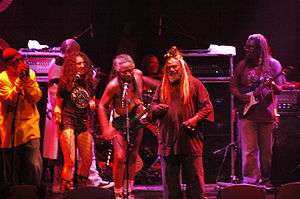
Some styles of music place an emphasis on certain of these fundamentals, while others place less emphasis on certain elements. To give one example, while Bebop-era jazz makes use of very complex chords, including altered dominants and challenging chord progressions, with chords changing two or more times per bar and keys changing several times in a tune, funk places most of its emphasis on rhythm and groove, with entire songs based around a vamp on a single chord. While Romantic era classical music from the mid- to late-1800s makes great use of dramatic changes of dynamics, from whispering pianissimo sections to thunderous fortissimo sections, some entire Baroque dance suites for harpsichord from the early 1700s may use a single dynamic. To give another example, while some art music pieces, such as symphonies are very long, some pop songs are just a few minutes long.
History
Early history
_(9420310527).jpg)
Prehistoric music can only be theorized based on findings from paleolithic archaeology sites. Flutes are often discovered, carved from bones in which lateral holes have been pierced; these are thought to have been blown at one end like the Japanese shakuhachi. The Divje Babe flute, carved from a cave bear femur, is thought to be at least 40,000 years old. Instruments such as the seven-holed flute and various types of stringed instruments, such as the Ravanahatha, have been recovered from the Indus Valley Civilization archaeological sites.[32] India has one of the oldest musical traditions in the world—references to Indian classical music (marga) are found in the Vedas, ancient scriptures of the Hindu tradition.[33] The earliest and largest collection of prehistoric musical instruments was found in China and dates back to between 7000 and 6600 BC.[34] The "Hurrian Hymn to Nikkal", found on clay tablets that date back to approximately 1400 BC, is the oldest surviving notated work of music.[35][36]
Ancient Egypt
The ancient Egyptians credited one of their gods, Thoth, with the invention of music, with Osiris in turn used as part of his effort to civilize the world. The earliest material and representational evidence of Egyptian musical instruments dates to the Predynastic period, but the evidence is more securely attested in the Old Kingdom when harps, flutes and double clarinets were played.[37] Percussion instruments, lyres and lutes were added to orchestras by the Middle Kingdom. Cymbals[38] frequently accompanied music and dance, much as they still do in Egypt today. Egyptian folk music, including the traditional Sufi dhikr rituals, are the closest contemporary music genre to ancient Egyptian music, having preserved many of its features, rhythms and instruments.[39][40]
Asian cultures
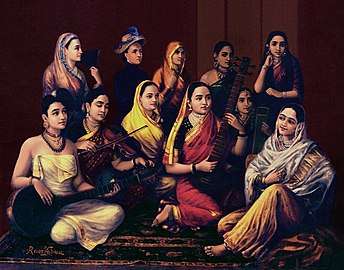
| Gangubai Hangal Durga |
|---|
Asian music covers a vast swath of music cultures surveyed in the articles on Arabia, Central Asia, East Asia, South Asia, and Southeast Asia. Several have traditions reaching into antiquity.
Indian classical music is one of the oldest musical traditions in the world.[41] The Indus Valley civilization has sculptures that show dance[42] and old musical instruments, like the seven holed flute. Various types of stringed instruments and drums have been recovered from Harappa and Mohenjo Daro by excavations carried out by Sir Mortimer Wheeler.[43] The Rigveda has elements of present Indian music, with a musical notation to denote the metre and the mode of chanting.[44] Indian classical music (marga) is monophonic, and based on a single melody line or raga rhythmically organized through talas. Silappadhikaram by Ilango Adigal provides information about how new scales can be formed by modal shifting of the tonic from an existing scale.[45] Present day Hindi music was influenced by Persian traditional music and Afghan Mughals. Carnatic music, popular in the southern states, is largely devotional; the majority of the songs are addressed to the Hindu deities. There are also many songs emphasising love and other social issues.
Chinese classical music, the traditional art or court music of China, has a history stretching over around three thousand years. It has its own unique systems of musical notation, as well as musical tuning and pitch, musical instruments and styles or musical genres. Chinese music is pentatonic-diatonic, having a scale of twelve notes to an octave (5 + 7 = 12) as does European-influenced music.
References in the Bible

Knowledge of the biblical period is mostly from literary references in the Bible and post-biblical sources. Religion and music historian Herbert Lockyer, Jr. writes that "music, both vocal and instrumental, was well cultivated among the Hebrews, the New Testament Christians, and the Christian church through the centuries."[46] He adds that "a look at the Old Testament reveals how God's ancient people were devoted to the study and practice of music, which holds a unique place in the historical and prophetic books, as well as the Psalter."
Music and theatre scholars studying the history and anthropology of Semitic and early Judeo-Christian culture have discovered common links in theatrical and musical activity between the classical cultures of the Hebrews and those of later Greeks and Romans. The common area of performance is found in a "social phenomenon called litany," a form of prayer consisting of a series of invocations or supplications. The Journal of Religion and Theatre notes that among the earliest forms of litany, "Hebrew litany was accompanied by a rich musical tradition:"[47]
Genesis 4.21 indicated that Jubal is the "father of all such as handle the harp and pipe", the Pentateuch is nearly silent about the practice and instruction of music in the early life of Israel". In I Samuel 10, there are more depictions of "large choirs and orchestras". These large ensembles could only be run with extensive rehearsals. This had led some scholars to theorize that the prophet Samuel led a public music school to a wide range of students.[47]
Ancient Greece
Music was an important part of social and cultural life in ancient Greece. Musicians and singers played a prominent role in Greek theater.[48] Mixed-gender choruses performed for entertainment, celebration, and spiritual ceremonies.[49] Instruments included the double-reed aulos and a plucked string instrument, the lyre, principally the special kind called a kithara. Music was an important part of education, and boys were taught music starting at age six. Greek musical literacy created a flowering of music development. Greek music theory included the Greek musical modes, that eventually became the basis for Western religious and classical music. Later, influences from the Roman Empire, Eastern Europe, and the Byzantine Empire changed Greek music. The Seikilos epitaph is the oldest surviving example of a complete musical composition, including musical notation, from anywhere in the world.[50] The oldest surviving work written on the subject of music theory is Harmonika Stoicheia by Aristoxenus.[51]
Middle Ages
| Léonin or Pérotin Breves dies hominis |
|---|

The medieval era (476 to 1400), which took place during the Middle Ages, started with the introduction of monophonic (single melodic line) chanting into Roman Catholic Church services. Musical notation was used since Ancient times in Greek culture, but in the Middle Ages, notation was first introduced by the Catholic church so that the chant melodies could be written down, to facilitate the use of the same melodies for religious music across the entire Catholic empire. The only European Medieval repertory that has been found in written form from before 800 is the monophonic liturgical plainsong chant of the Roman Catholic Church, the central tradition of which was called Gregorian chant. Alongside these traditions of sacred and church music there existed a vibrant tradition of secular song (non-religious songs). Examples of composers from this period are Léonin, Pérotin, Guillaume de Machaut, and Walther von der Vogelweide.
Renaissance
| T.L. de Victoria Amicus meus |
|---|

Renaissance music (c. 1400 to 1600) was more focused on secular (non-religious) themes, such as courtly love. Around 1450, the printing press was invented, which made printed sheet music much less expensive and easier to mass-produce (prior to the invention of the printing press, all notated music was hand-copied). The increased availability of sheet music helped to spread musical styles more quickly and across a larger area. Musicians and singers often worked for the church, courts and towns. Church choirs grew in size, and the church remained an important patron of music. By the middle of the 15th century, composers wrote richly polyphonic sacred music, in which different melody lines were interwoven simultaneously. Prominent composers from this era include Guillaume Dufay, Giovanni Pierluigi da Palestrina, Thomas Morley, and Orlande de Lassus. As musical activity shifted from the church to the aristocratic courts, kings, queens and princes competed for the finest composers. Many leading important composers came from the Netherlands, Belgium, and northern France. They are called the Franco-Flemish composers. They held important positions throughout Europe, especially in Italy. Other countries with vibrant musical activity included Germany, England, and Spain.
Baroque
| J.S. Bach Toccata and Fugue |
|---|
The Baroque era of music took place from 1600 to 1750, as the Baroque artistic style flourished across Europe; and during this time, music expanded in its range and complexity. Baroque music began when the first operas (dramatic solo vocal music accompanied by orchestra) were written. During the Baroque era, polyphonic contrapuntal music, in which multiple, simultaneous independent melody lines were used, remained important (counterpoint was important in the vocal music of the Medieval era). German Baroque composers wrote for small ensembles including strings, brass, and woodwinds, as well as for choirs and keyboard instruments such as pipe organ, harpsichord, and clavichord. During this period several major music forms were defined that lasted into later periods when they were expanded and evolved further, including the fugue, the invention, the sonata, and the concerto.[52] The late Baroque style was polyphonically complex and richly ornamented. Important composers from the Baroque era include Johann Sebastian Bach (Cello suites), George Frideric Handel (Messiah), Georg Philipp Telemann and Antonio Lucio Vivaldi (The Four Seasons).
Classicism
| W.A. Mozart Symphony 40 G minor |
|---|

The music of the Classical period (1730 to 1820) aimed to imitate what were seen as the key elements of the art and philosophy of Ancient Greece and Rome: the ideals of balance, proportion and disciplined expression. (Note: the music from the Classical period should not be confused with Classical music in general, a term which refers to Western art music from the 5th century to the 2000s, which includes the Classical period as one of a number of periods). Music from the Classical period has a lighter, clearer and considerably simpler texture than the Baroque music which preceded it. The main style was homophony,[53] where a prominent melody and a subordinate chordal accompaniment part are clearly distinct. Classical instrumental melodies tended to be almost voicelike and singable. New genres were developed, and the fortepiano, the forerunner to the modern piano, replaced the Baroque era harpsichord and pipe organ as the main keyboard instrument (though pipe organ continued to be used in sacred music, such as Masses).
Importance was given to instrumental music. It was dominated by further development of musical forms initially defined in the Baroque period: the sonata, the concerto, and the symphony. Others main kinds were the trio, string quartet, serenade and divertimento. The sonata was the most important and developed form. Although Baroque composers also wrote sonatas, the Classical style of sonata is completely distinct. All of the main instrumental forms of the Classical era, from string quartets to symphonies and concertos, were based on the structure of the sonata. The instruments used chamber music and orchestra became more standardized. In place of the basso continuo group of the Baroque era, which consisted of harpsichord, organ or lute along with a number of bass instruments selected at the discretion of the group leader (e.g., viol, cello, theorbo, serpent), Classical chamber groups used specified, standardized instruments (e.g., a string quartet would be performed by two violins, a viola and a cello). The Baroque era improvised chord-playing of the continuo keyboardist or lute player was gradually phased out between 1750 and 1800.
One of the most important changes made in the Classical period was the development of public concerts. The aristocracy still played a significant role in the sponsorship of concerts and compositions, but it was now possible for composers to survive without being permanent employees of queens or princes. The increasing popularity of classical music led to a growth in the number and types of orchestras. The expansion of orchestral concerts necessitated the building of large public performance spaces. Symphonic music including symphonies, musical accompaniment to ballet and mixed vocal/instrumental genres such as opera and oratorio became more popular.
The best known composers of Classicism are Carl Philipp Emanuel Bach, Christoph Willibald Gluck, Johann Christian Bach, Joseph Haydn, Wolfgang Amadeus Mozart, Ludwig van Beethoven and Franz Schubert. Beethoven and Schubert are also considered to be composers in the later part of the Classical era, as it began to move towards Romanticism.
Romanticism
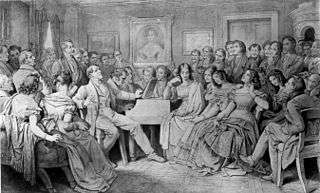
| R. Wagner Die Walküre |
|---|
Romantic music (c. 1810 to 1900) from the 19th century had many elements in common with the Romantic styles in literature and painting of the era. Romanticism was an artistic, literary, and intellectual movement was characterized by its emphasis on emotion and individualism as well as glorification of all the past and nature. Romantic music expanded beyond the rigid styles and forms of the Classical era into more passionate, dramatic expressive pieces and songs. Romantic composers such as Wagner and Brahms attempted to increase emotional expression and power in their music to describe deeper truths or human feelings. With symphonic tone poems, composers tried to tell stories and evoke images or landscapes using instrumental music. Some composers promoted nationalistic pride with patriotic orchestral music inspired by folk music. The emotional and expressive qualities of music came to take precedence over tradition.
Romantic composers grew in idiosyncrasy, and went further in the syncretism of exploring different art-forms in a musical context, (such as literature), history (historical figures and legends), or nature itself. Romantic love or longing was a prevalent theme in many works composed during this period. In some cases the formal structures from the classical period continued to be used (e.g., the sonata form used in string quartets and symphonies), but these forms were expanded and altered. In many cases, new approaches were explored for existing genres, forms, and functions. Also, new forms were created that were deemed better suited to the new subject matter. Composers continued to develop opera and ballet music, exploring new styles and themes.[48]
In the years after 1800, the music developed by Ludwig van Beethoven and Franz Schubert introduced a more dramatic, expressive style. In Beethoven's case, short motifs, developed organically, came to replace melody as the most significant compositional unit (an example is the distinctive four note figure used in his Fifth Symphony). Later Romantic composers such as Pyotr Ilyich Tchaikovsky, Antonín Dvořák, and Gustav Mahler used more unusual chords and more dissonance to create dramatic tension. They generated complex and often much longer musical works. During the late Romantic period, composers explored dramatic chromatic alterations of tonality, such as extended chords and altered chords, which created new sound "colours". The late 19th century saw a dramatic expansion in the size of the orchestra, and the industrial revolution helped to create better instruments, creating a more powerful sound. Public concerts became an important part of well-to-do urban society. It also saw a new diversity in theatre music, including operetta, and musical comedy and other forms of musical theatre.[48]
20th and 21st century music
In the 19th century, one of the key ways that new compositions became known to the public was by the sales of sheet music, which middle class amateur music lovers would perform at home on their piano or other common instruments, such as violin. With 20th-century music, the invention of new electric technologies such as radio broadcasting and the mass market availability of gramophone records meant that sound recordings of songs and pieces heard by listeners (either on the radio or on their record player) became the main way to learn about new songs and pieces. There was a vast increase in music listening as the radio gained popularity and phonographs were used to replay and distribute music, because whereas in the 19th century, the focus on sheet music restricted access to new music to the middle class and upper-class people who could read music and who owned pianos and instruments, in the 20th century, anyone with a radio or record player could hear operas, symphonies and big bands right in their own living room. This allowed lower-income people, who would never be able to afford an opera or symphony concert ticket to hear this music. It also meant that people could hear music from different parts of the country, or even different parts of the world, even if they could not afford to travel to these locations. This helped to spread musical styles.
The focus of art music in the 20th century was characterized by exploration of new rhythms, styles, and sounds. The horrors of World War I influenced many of the arts, including music, and some composers began exploring darker, harsher sounds. Traditional music styles such as jazz and folk music were used by composers as a source of ideas for classical music. Igor Stravinsky, Arnold Schoenberg, and John Cage were all influential composers in 20th-century art music. The invention of sound recording and the ability to edit music gave rise to new subgenre of classical music, including the acousmatic[54] and Musique concrète schools of electronic composition. Sound recording was also a major influence on the development of popular music genres, because it enabled recordings of songs and bands to be widely distributed. The introduction of the multitrack recording system had a major influence on rock music, because it could do much more than record a band's performance. Using a multitrack system, a band and their music producer could overdub many layers of instrument tracks and vocals, creating new sounds that would not be possible in a live performance.
Jazz evolved and became an important genre of music over the course of the 20th century, and during the second half of that century, rock music did the same. Jazz is an American musical artform that originated in the beginning of the 20th century in African American communities in the Southern United States from a confluence of African and European music traditions. The style's West African pedigree is evident in its use of blue notes, improvisation, polyrhythms, syncopation, and the swung note.[55]
Rock music is a genre of popular music that developed in the 1960s from 1950s rock and roll, rockabilly, blues, and country music.[56] The sound of rock often revolves around the electric guitar or acoustic guitar, and it uses a strong back beat laid down by a rhythm section. Along with the guitar or keyboards, saxophone and blues-style harmonica are used as soloing instruments. In its "purest form", it "has three chords, a strong, insistent back beat, and a catchy melody". The traditional rhythm section for popular music is rhythm guitar, electric bass guitar, drums. Some bands also have keyboard instruments such as organ, piano, or, since the 1970s, analog synthesizers. In the 1980s, pop musicians began using digital synthesizers, such as the DX-7 synthesizer, electronic drum machines such as the TR-808 and synth bass devices (such as the TB-303) or synth bass keyboards. In the 1990s, an increasingly large range of computerized hardware musical devices and instruments and software (e.g., digital audio workstations) were used. In the 2020s, soft synths and computer music apps make it possible for bedroom producers to create and record some types of music, such as electronic dance music in their own home, adding sampled and digital instruments and editing the recording digitally. In the 1990s, some bands in genres such as nu metal began including DJs in their bands. DJs create music by manipulating recorded music on record players or CD players, using a DJ mixer.
Performance
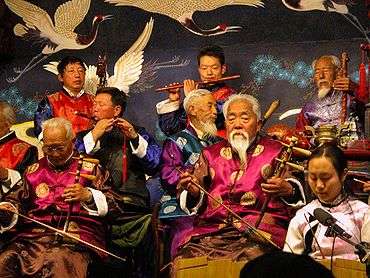
Performance is the physical expression of music, which occurs when a song is sung or when a piano piece, electric guitar melody, symphony, drum beat or other musical part is played by musicians. In classical music, a musical work is written in music notation by a composer and then it is performed once the composer is satisfied with its structure and instrumentation. However, as it gets performed, the interpretation of a song or piece can evolve and change. In classical music, instrumental performers, singers or conductors may gradually make changes to the phrasing or tempo of a piece. In popular and traditional music, the performers have a lot more freedom to make changes to the form of a song or piece. As such, in popular and traditional music styles, even when a band plays a cover song, they can make changes to it such as adding a guitar solo to or inserting an introduction.
A performance can either be planned out and rehearsed (practiced)—which is the norm in classical music, with jazz big bands and many popular music styles–or improvised over a chord progression (a sequence of chords), which is the norm in small jazz and blues groups. Rehearsals of orchestras, concert bands and choirs are led by a conductor. Rock, blues and jazz bands are usually led by the bandleader. A rehearsal is a structured repetition of a song or piece by the performers until it can be sung and/or played correctly and, if it is a song or piece for more than one musician, until the parts are together from a rhythmic and tuning perspective. Improvisation is the creation of a musical idea–a melody or other musical line–created on the spot, often based on scales or pre-existing melodic riffs.
Many cultures have strong traditions of solo performance (in which one singer or instrumentalist performs), such as in Indian classical music, and in the Western art-music tradition. Other cultures, such as in Bali, include strong traditions of group performance. All cultures include a mixture of both, and performance may range from improvised solo playing to highly planned and organised performances such as the modern classical concert, religious processions, classical music festivals or music competitions. Chamber music, which is music for a small ensemble with only a few of each type of instrument, is often seen as more intimate than large symphonic works.
Oral and aural tradition
Many types of music, such as traditional blues and folk music were not written down in sheet music; instead, they were originally preserved in the memory of performers, and the songs were handed down orally, from one musician or singer to another, or aurally, in which a performer learns a song "by ear". When the composer of a song or piece is no longer known, this music is often classified as "traditional" or as a "folk song". Different musical traditions have different attitudes towards how and where to make changes to the original source material, from quite strict, to those that demand improvisation or modification to the music. A culture's history and stories may also be passed on by ear through song.
Ornamentation
In music, an ornament consists of added notes that provide decoration to a melody, bassline or other musical part. The detail included explicitly in the music notation varies between genres and historical periods. In general, art music notation from the 17th through the 19th centuries required performers to have a great deal of contextual knowledge about performing styles. For example, in the 17th and 18th centuries, music notated for solo performers typically indicated a simple, unadorned melody. Performers were expected to know how to add stylistically appropriate ornaments to add interest to the music, such as trills and turns. Different styles of music use different ornaments. A Baroque flute player might add mordents, which are short notes that are played before the main melody note, either above or below the main melody note. A blues guitarist playing electric guitar might use string bending to add expression; a heavy metal guitar player might use hammer-ons and pull-offs.
In the 19th century, art music for solo performers may give a general instruction such as to perform the music expressively, without describing in detail how the performer should do this. The performer was expected to know how to use tempo changes, accentuation, and pauses (among other devices) to obtain this "expressive" performance style. In the 20th century, art music notation often became more explicit and used a range of markings and annotations to indicate to performers how they should play or sing the piece. In popular music and traditional music styles, performers are expected to know what types of ornaments are stylistically appropriate for a given song or piece, and performers typically add them in an improvised fashion. One exception is note-for-note solos, in which some players precisely recreate a famous version of a solo, such as a guitar solo.
Philosophy and aesthetics
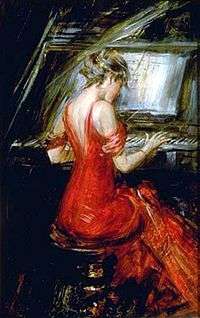
Philosophy of music is a subfield of philosophy. The philosophy of music is the study of fundamental questions regarding music. The philosophical study of music has many connections with philosophical questions in metaphysics and aesthetics. Some basic questions in the philosophy of music are:
- What is the definition of music? (What are the necessary and sufficient conditions for classifying something as music?)
- What is the relationship between music and mind?
- What does music history reveal to us about the world?
- What is the connection between music and emotions?
- What is meaning in relation to music?
In ancient times, such as with the Ancient Greeks, the aesthetics of music explored the mathematical and cosmological dimensions of rhythmic and harmonic organization. In the 18th century, focus shifted to the experience of hearing music, and thus to questions about its beauty and human enjoyment (plaisir and jouissance) of music. The origin of this philosophic shift is sometimes attributed to Alexander Gottlieb Baumgarten in the 18th century, followed by Immanuel Kant. Through their writing, the ancient term 'aesthetics', meaning sensory perception, received its present-day connotation. In the 2000s, philosophers have tended to emphasize issues besides beauty and enjoyment. For example, music's capacity to express emotion has been a central issue.
In the 20th century, important contributions were made by Peter Kivy, Jerrold Levinson, Roger Scruton, and Stephen Davies. However, many musicians, music critics, and other non-philosophers have contributed to the aesthetics of music. In the 19th century, a significant debate arose between Eduard Hanslick, a music critic and musicologist, and composer Richard Wagner regarding whether music can express meaning. Harry Partch and some other musicologists, such as Kyle Gann, have studied and tried to popularize microtonal music and the usage of alternate musical scales. Also many modern composers like La Monte Young, Rhys Chatham and Glenn Branca paid much attention to a scale called just intonation.
It is often thought that music has the ability to affect our emotions, intellect, and psychology; it can assuage our loneliness or incite our passions. The philosopher Plato suggests in The Republic that music has a direct effect on the soul. Therefore, he proposes that in the ideal regime music would be closely regulated by the state (Book VII).
There has been a strong tendency in the aesthetics of music to emphasize the paramount importance of compositional structure; however, other issues concerning the aesthetics of music include lyricism, harmony, hypnotism, emotiveness, temporal dynamics, resonance, playfulness, and color (see also musical development).
Psychology
Modern music psychology aims to explain and understand musical behavior and experience.[57] Research in this field and its subfields are primarily empirical; their knowledge tends to advance on the basis of interpretations of data collected by systematic observation of and interaction with human participants. In addition to its focus on fundamental perceptions and cognitive processes, music psychology is a field of research with practical relevance for many areas, including music performance, composition, education, criticism, and therapy, as well as investigations of human aptitude, skill, intelligence, creativity, and social behavior.
Cognitive neuroscience of music
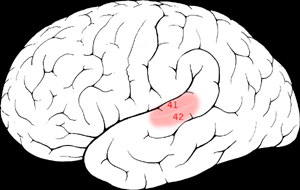
Cognitive neuroscience of music is the scientific study of brain-based mechanisms involved in the cognitive processes underlying music. These behaviours include music listening, performing, composing, reading, writing, and ancillary activities. It also is increasingly concerned with the brain basis for musical aesthetics and musical emotion. The field is distinguished by its reliance on direct observations of the brain, using such techniques as functional magnetic resonance imaging (fMRI), transcranial magnetic stimulation (TMS), magnetoencephalography (MEG), electroencephalography (EEG), and positron emission tomography (PET).
Cognitive musicology
Cognitive musicology is a branch of cognitive science concerned with computationally modeling musical knowledge with the goal of understanding both music and cognition.[58] The use of computer models provides an exacting, interactive medium in which to formulate and test theories and has roots in artificial intelligence and cognitive science.[59]
This interdisciplinary field investigates topics such as the parallels between language and music in the brain. Biologically inspired models of computation are often included in research, such as neural networks and evolutionary programs.[60] This field seeks to model how musical knowledge is represented, stored, perceived, performed, and generated. By using a well-structured computer environment, the systematic structures of these cognitive phenomena can be investigated.[61]
Psychoacoustics
Psychoacoustics is the scientific study of sound perception. More specifically, it is the branch of science studying the psychological and physiological responses associated with sound (including speech and music). It can be further categorized as a branch of psychophysics.
Evolutionary musicology
Evolutionary musicology concerns the "origins of music, the question of animal song, selection pressures underlying music evolution", and "music evolution and human evolution".[62] It seeks to understand music perception and activity in the context of evolutionary theory. Charles Darwin speculated that music may have held an adaptive advantage and functioned as a protolanguage,[63] a view which has spawned several competing theories of music evolution.[64][65][66] An alternate view sees music as a by-product of linguistic evolution; a type of "auditory cheesecake" that pleases the senses without providing any adaptive function.[67] This view has been directly countered by numerous music researchers.[68][69][70]
Culture in music cognition
An individual's culture or ethnicity plays a role in their music cognition, including their preferences, emotional reaction, and musical memory. Musical preferences are biased toward culturally familiar musical traditions beginning in infancy, and adults' classification of the emotion of a musical piece depends on both culturally specific and universal structural features.[71][72] Additionally, individuals' musical memory abilities are greater for culturally familiar music than for culturally unfamiliar music.[73][74]
Sociological aspects

Many ethnographic studies demonstrate that music is a participatory, community-based activity.[75][76] Music is experienced by individuals in a range of social settings ranging from being alone to attending a large concert, forming a music community, which cannot be understood as a function of individual will or accident; it includes both commercial and non-commercial participants with a shared set of common values. Musical performances take different forms in different cultures and socioeconomic milieus. In Europe and North America, there is often a divide between what types of music are viewed as a "high culture" and "low culture." "High culture" types of music typically include Western art music such as Baroque, Classical, Romantic, and modern-era symphonies, concertos, and solo works, and are typically heard in formal concerts in concert halls and churches, with the audience sitting quietly in seats.
Other types of music—including, but not limited to, jazz, blues, soul, and country—are often performed in bars, nightclubs, and theatres, where the audience may be able to drink, dance, and express themselves by cheering. Until the later 20th century, the division between "high" and "low" musical forms was widely accepted as a valid distinction that separated out better quality, more advanced "art music" from the popular styles of music heard in bars and dance halls.
However, in the 1980s and 1990s, musicologists studying this perceived divide between "high" and "low" musical genres argued that this distinction is not based on the musical value or quality of the different types of music. Rather, they argued that this distinction was based largely on the socioeconomics standing or social class of the performers or audience of the different types of music. For example, whereas the audience for Classical symphony concerts typically have above-average incomes, the audience for a rap concert in an inner-city area may have below-average incomes. Even though the performers, audience, or venue where non-"art" music is performed may have a lower socioeconomic status, the music that is performed, such as blues, rap, punk, funk, or ska may be very complex and sophisticated.
When composers introduce styles of music that break with convention, there can be a strong resistance from academic music experts and popular culture. Late-period Beethoven string quartets, Stravinsky ballet scores, serialism, bebop-era jazz, hip hop, punk rock, and electronica have all been considered non-music by some critics when they were first introduced. Such themes are examined in the sociology of music. The sociological study of music, sometimes called sociomusicology, is often pursued in departments of sociology, media studies, or music, and is closely related to the field of ethnomusicology.
Role of women
.jpg)
Women have played a major role in music throughout history, as composers, songwriters, instrumental performers, singers, conductors, music scholars, music educators, music critics/music journalists and other musical professions. As well, it describes music movements, events and genres related to women, women's issues and feminism. In the 2010s, while women comprise a significant proportion of popular music and classical music singers, and a significant proportion of songwriters (many of them being singer-songwriters), there are few women record producers, rock critics and rock instrumentalists. Although there have been a huge number of women composers in classical music, from the Medieval period to the present day, women composers are significantly underrepresented in the commonly performed classical music repertoire, music history textbooks and music encyclopedias; for example, in the Concise Oxford History of Music, Clara Schumann is one of the only female composers who is mentioned.
Women comprise a significant proportion of instrumental soloists in classical music and the percentage of women in orchestras is increasing. A 2015 article on concerto soloists in major Canadian orchestras, however, indicated that 84% of the soloists with the Orchestre Symphonique de Montreal were men. In 2012, women still made up just 6% of the top-ranked Vienna Philharmonic orchestra. Women are less common as instrumental players in popular music genres such as rock and heavy metal, although there have been a number of notable female instrumentalists and all-female bands. Women are particularly underrepresented in extreme metal genres.[77] In the 1960s pop-music scene, "[l]ike most aspects of the...music business, [in the 1960s,] songwriting was a male-dominated field. Though there were plenty of female singers on the radio, women ...were primarily seen as consumers:... Singing was sometimes an acceptable pastime for a girl, but playing an instrument, writing songs, or producing records simply wasn't done."[78] Young women "...were not socialized to see themselves as people who create [music]."[78]
Women are also underrepresented in orchestral conducting, music criticism/music journalism, music producing, and sound engineering. While women were discouraged from composing in the 19th century, and there are few women musicologists, women became involved in music education "...to such a degree that women dominated [this field] during the later half of the 19th century and well into the 20th century."[79]
According to Jessica Duchen, a music writer for London's The Independent, women musicians in classical music are "...too often judged for their appearances, rather than their talent" and they face pressure "...to look sexy onstage and in photos."[80] Duchen states that while "[t]here are women musicians who refuse to play on their looks,...the ones who do tend to be more materially successful."[80] According to the UK's Radio 3 editor, Edwina Wolstencroft, the music industry has long been open to having women in performance or entertainment roles, but women are much less likely to have positions of authority, such as being the leader of an orchestra.[81] In popular music, while there are many women singers recording songs, there are very few women behind the audio console acting as music producers, the individuals who direct and manage the recording process.[82] One of the most recorded artists is Asha Bhosle, an Indian singer best known as a playback singer in Hindi cinema.
Media and technology
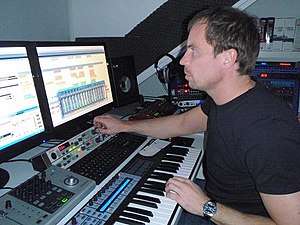
The music that composers and songwriters make can be heard through several media; the most traditional way is to hear it live, in the presence of the musicians (or as one of the musicians), in an outdoor or indoor space such as an amphitheatre, concert hall, cabaret room, theatre, pub, or coffeehouse. Since the 20th century, live music can also be broadcast over the radio, television or the Internet, or recorded and listened to on a CD player or Mp3 player.
Some musical styles focus on producing songs and pieces for a live performance, while others focus on producing a recording that mixes together sounds that were never played "live." Even in essentially live styles such as rock, recording engineers often use the ability to edit, splice and mix to produce recordings that may be considered "better" than the actual live performance. For example, some singers record themselves singing a melody and then record multiple harmony parts using overdubbing, creating a sound that would be impossible to do live.
Technology has had an influence on music since prehistoric times, when cave people used simple tools to bore holes into bone flutes 41,000 years ago. Technology continued to influence music throughout the history of music, as it enabled new instruments and music notation reproduction systems to be used, with one of the watershed moments in music notation being the invention of the printing press in the 1400s, which meant music scores no longer had to be hand copied. In the 19th century, music technology led to the development of a more powerful, louder piano and led to the development of new valves brass instruments.
In the early 20th century (in the late 1920s), as talking pictures emerged in the early 20th century, with their prerecorded musical tracks, an increasing number of moviehouse orchestra musicians found themselves out of work.[83] During the 1920s, live musical performances by orchestras, pianists, and theater organists were common at first-run theaters.[84] With the coming of the talking motion pictures, those featured performances were largely eliminated. The American Federation of Musicians (AFM) took out newspaper advertisements protesting the replacement of live musicians with mechanical playing devices. One 1929 ad that appeared in the Pittsburgh Press features an image of a can labeled "Canned Music / Big Noise Brand / Guaranteed to Produce No Intellectual or Emotional Reaction Whatever"[85]
Since legislation introduced to help protect performers, composers, publishers and producers, including the Audio Home Recording Act of 1992 in the United States, and the 1979 revised Berne Convention for the Protection of Literary and Artistic Works in the United Kingdom, recordings and live performances have also become more accessible through computers, devices and Internet in a form that is commonly known as Music-On-Demand.
In many cultures, there is less distinction between performing and listening to music, since virtually everyone is involved in some sort of musical activity, often in a communal setting. In industrialized countries, listening to music through a recorded form, such as sound recording on record or radio became more common than experiencing live performance, roughly in the middle of the 20th century. By the 1980s, watching music videos was a popular way to listen to music, while also seeing the performers.
Sometimes, live performances incorporate prerecorded sounds. For example, a disc jockey uses disc records for scratching, and some 20th-century works have a solo for an instrument or voice that is performed along with music that is prerecorded onto a tape. Some pop bands use recorded backing tracks. Computers and many keyboards can be programmed to produce and play Musical Instrument Digital Interface (MIDI) music. Audiences can also become performers by participating in karaoke, an activity of Japanese origin centered on a device that plays voice-eliminated versions of well-known songs. Most karaoke machines also have video screens that show lyrics to songs being performed; performers can follow the lyrics as they sing over the instrumental tracks.
Internet
The advent of the Internet and widespread high-speed broadband access has transformed the experience of music, partly through the increased ease of access to recordings of music via streaming video and vastly increased choice of music for consumers. Chris Anderson, in his book The Long Tail: Why the Future of Business Is Selling Less of More, suggests that while the traditional economic model of supply and demand describes scarcity, the Internet retail model is based on abundance. Digital storage costs are low, so a company can afford to make its whole recording inventory available online, giving customers as much choice as possible. It has thus become economically viable to offer music recordings that very few people are interested in. Consumers' growing awareness of their increased choice results in a closer association between listening tastes and social identity, and the creation of thousands of niche markets.[86]
Another effect of the Internet arose with online communities and social media websites like YouTube and Facebook, a social networking service. These sites make it easier for aspiring singers and amateur bands to distribute videos of their songs, connect with other musicians, and gain audience interest. Professional musicians also use YouTube as a free publisher of promotional material. YouTube users, for example, no longer only download and listen to MP3s, but also actively create their own. According to Don Tapscott and Anthony D. Williams, in their book Wikinomics, there has been a shift from a traditional consumer role to what they call a "prosumer" role, a consumer who both creates content and consumes. Manifestations of this in music include the production of mashes, remixes, and music videos by fans.[87]
Business
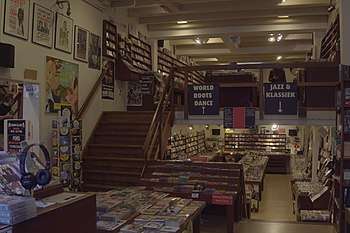
The music industry refers to the businesses connected with the creation and sale of music. It consists of songwriters and composers who create new songs and musical pieces, music producers and sound engineers who record songs and pieces, record labels and publishers that distribute recorded music products and sheet music internationally and that often control the rights to those products. Some music labels are "independent," while others are subsidiaries of larger corporate entities or international media groups. In the 2000s, the increasing popularity of listening to music as digital music files on MP3 players, iPods, or computers, and of trading music on file sharing websites or buying it online in the form of digital files had a major impact on the traditional music business. Many smaller independent CD stores went out of business as music buyers decreased their purchases of CDs, and many labels had lower CD sales. Some companies did well with the change to a digital format, though, such as Apple's iTunes, an online music store that sells digital files of songs over the Internet.
Intellectual property laws
In spite of some international copyright treaties, determining which music is in the public domain is complicated by the variety of national copyright laws that may be applicable. US copyright law formerly protected printed music published after 1923 for 28 years and with renewal for another 28 years, but the Copyright Act of 1976 made renewal automatic, and the Digital Millennium Copyright Act changed the calculation of the copyright term to 70 years after the death of the creator. Recorded sound falls under mechanical licensing, often covered by a confusing patchwork of state laws; most cover versions are licensed through the Harry Fox Agency. Performance rights may be obtained by either performers or the performance venue; the two major organizations for licensing are BMI and ASCAP. Two online sources for public domain music are IMSLP (International Music Score Library Project) and Choral Public Domain Library (CPDL).
Education
Non-professional
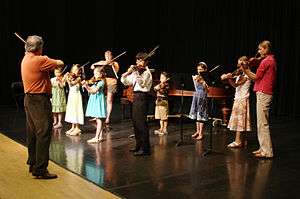
The incorporation of some music or singing training into general education from preschool to post secondary education is common in North America and Europe. Involvement in playing and singing music is thought to teach basic skills such as concentration, counting, listening, and cooperation while also promoting understanding of language, improving the ability to recall information, and creating an environment more conducive to learning in other areas.[88] In elementary schools, children often learn to play instruments such as the recorder, sing in small choirs, and learn about the history of Western art music and traditional music. Some elementary school children also learn about popular music styles. In religious schools, children sing hymns and other religious music. In secondary schools (and less commonly in elementary schools), students may have the opportunity to perform in some types of musical ensembles, such as choirs (a group of singers), marching bands, concert bands, jazz bands, or orchestras. In some school systems, music lessons on how to play instruments may be provided. Some students also take private music lessons after school with a singing teacher or instrument teacher. Amateur musicians typically learn basic musical rudiments (e.g., learning about musical notation for musical scales and rhythms) and beginner- to intermediate-level singing or instrument-playing techniques.
At the university level, students in most arts and humanities programs can receive credit for taking a few music courses, which typically take the form of an overview course on the history of music, or a music appreciation course that focuses on listening to music and learning about different musical styles. In addition, most North American and European universities have some types of musical ensembles that students in arts and humanities are able to participate in, such as choirs, marching bands, concert bands, or orchestras. The study of Western art music is increasingly common outside of North America and Europe, such as the Indonesian Institute of the Arts in Yogyakarta, Indonesia, or the classical music programs that are available in Asian countries such as South Korea, Japan, and China. At the same time, Western universities and colleges are widening their curriculum to include music of non-Western cultures, such as the music of Africa or Bali (e.g. Gamelan music).
Professional training

Individuals aiming to become professional musicians, singers, composers, songwriters, music teachers and practitioners of other music-related professions such as music history professors, sound engineers, and so on study in specialized post-secondary programs offered by colleges, universities and music conservatories. Some institutions that train individuals for careers in music offer training in a wide range of professions, as is the case with many of the top U.S. universities, which offer degrees in music performance (including singing and playing instruments), music history, music theory, music composition, music education (for individuals aiming to become elementary or high school music teachers) and, in some cases, conducting. On the other hand, some small colleges may only offer training in a single profession (e.g., sound recording).
While most university and conservatory music programs focus on training students in classical music, there are a number of universities and colleges that train musicians for careers as jazz or popular music musicians and composers, with notable U.S. examples including the Manhattan School of Music and the Berklee College of Music. Two important schools in Canada which offer professional jazz training are McGill University and Humber College. Individuals aiming at careers in some types of music, such as heavy metal music, country music or blues are less likely to become professionals by completing degrees or diplomas in colleges or universities. Instead, they typically learn about their style of music by singing and/or playing in many bands (often beginning in amateur bands, cover bands and tribute bands), studying recordings available on CD, DVD and the Internet and working with already-established professionals in their style of music, either through informal mentoring or regular music lessons. Since the 2000s, the increasing popularity and availability of Internet forums and YouTube "how-to" videos have enabled many singers and musicians from metal, blues and similar genres to improve their skills. Many pop, rock and country singers train informally with vocal coaches and singing teachers.
Undergraduate
Undergraduate university degrees in music, including the Bachelor of Music, the Bachelor of Music Education, and the Bachelor of Arts (with a major in music) typically take about four years to complete. These degrees provide students with a grounding in music theory and music history, and many students also study an instrument or learn singing technique as part of their program. Graduates of undergraduate music programs can seek employment or go on to further study in music graduate programs. Bachelor's degree graduates are also eligible to apply to some graduate programs and professional schools outside of music (e.g., public administration, business administration, library science, and, in some jurisdictions, teacher's college, law school or medical school).
Graduate
Graduate music degrees include the Master of Music, the Master of Arts (in musicology, music theory or another music field), the Doctor of Philosophy (Ph.D.) (e.g., in musicology or music theory), and more recently, the Doctor of Musical Arts, or DMA. The Master of Music degree, which takes one to two years to complete, is typically awarded to students studying the performance of an instrument, education, voice (singing) or composition. The Master of Arts degree, which takes one to two years to complete and often requires a thesis, is typically awarded to students studying musicology, music history, music theory or ethnomusicology.
The PhD, which is required for students who want to work as university professors in musicology, music history, or music theory, takes three to five years of study after the master's degree, during which time the student will complete advanced courses and undertake research for a dissertation. The DMA is a relatively new degree that was created to provide a credential for professional performers or composers that want to work as university professors in musical performance or composition. The DMA takes three to five years after a master's degree, and includes advanced courses, projects, and performances. In Medieval times, the study of music was one of the Quadrivium of the seven Liberal Arts and considered vital to higher learning. Within the quantitative Quadrivium, music, or more accurately harmonics, was the study of rational proportions.
Musicology
Musicology, the academic study of the subject of music, is studied in universities and music conservatories. The earliest definitions from the 19th century defined three sub-disciplines of musicology: systematic musicology, historical musicology, and comparative musicology or ethnomusicology. In 2010-era scholarship, one is more likely to encounter a division of the discipline into music theory, music history, and ethnomusicology. Research in musicology has often been enriched by cross-disciplinary work, for example in the field of psychoacoustics. The study of music of non-Western cultures, and the cultural study of music, is called ethnomusicology. Students can pursue the undergraduate study of musicology, ethnomusicology, music history, and music theory through several different types of degrees, including bachelor's degrees, master's degrees and PhD degrees.
Music theory
Music theory is the study of music, generally in a highly technical manner outside of other disciplines. More broadly it refers to any study of music, usually related in some form with compositional concerns, and may include mathematics, physics, and anthropology. What is most commonly taught in beginning music theory classes are guidelines to write in the style of the common practice period, or tonal music. Theory, even of music of the common practice period, may take many other forms. Musical set theory is the application of mathematical set theory to music, first applied to atonal music. Speculative music theory, contrasted with analytic music theory, is devoted to the analysis and synthesis of music materials, for example tuning systems, generally as preparation for composition.
Zoomusicology
Zoomusicology is the study of the music of non-human animals, or the musical aspects of sounds produced by non-human animals. As George Herzog (1941) asked, "do animals have music?" François-Bernard Mâche's Musique, mythe, nature, ou les Dauphins d'Arion (1983), a study of "ornitho-musicology" using a technique of Nicolas Ruwet's Langage, musique, poésie (1972) paradigmatic segmentation analysis, shows that bird songs are organised according to a repetition-transformation principle. Jean-Jacques Nattiez (1990), argues that "in the last analysis, it is a human being who decides what is and is not musical, even when the sound is not of human origin. If we acknowledge that sound is not organised and conceptualised (that is, made to form music) merely by its producer, but by the mind that perceives it, then music is uniquely human."
Ethnomusicology
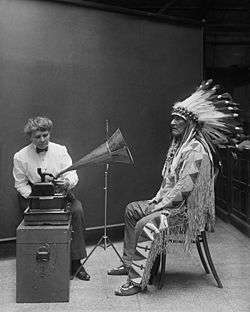
In the West, much of the history of music that is taught deals with the Western civilization's art music, which is known as classical music. The history of music in non-Western cultures ("world music" or the field of "ethnomusicology"), which typically covers music from Africa and Asia is also taught in Western universities. This includes the documented classical traditions of Asian countries outside the influence of Western Europe, as well as the folk or indigenous music of various other cultures. Popular or folk styles of music in non-Western countries varied widely from culture to culture, and from period to period. Different cultures emphasised different instruments, techniques, singing styles and uses for music. Music has been used for entertainment, ceremonies, rituals, religious purposes and for practical and artistic communication. Non-Western music has also been used for propaganda purposes, as was the case with Chinese opera during the Cultural Revolution.
There is a host of music classifications for non-Western music, many of which are caught up in the argument over the definition of music. Among the largest of these is the division between classical music (or "art" music), and popular music (or commercial music – including non-Western styles of rock, country, and pop music-related styles). Some genres do not fit neatly into one of these "big two" classifications, (such as folk music, world music, or jazz-related music).
As world cultures have come into greater global contact, their indigenous musical styles have often merged with other styles, which produces new styles. For example, the United States bluegrass style contains elements from Anglo-Irish, Scottish, Irish, German and African instrumental and vocal traditions, which were able to fuse in the United States' multi-ethnic "melting pot" society. Some types of world music contain a mixture of non-Western indigenous styles with Western pop music elements. Genres of music are determined as much by tradition and presentation as by the actual music. Some works, like George Gershwin's Rhapsody in Blue, are claimed by both jazz and classical music, while Gershwin's Porgy and Bess and Leonard Bernstein's West Side Story are claimed by both opera and the Broadway musical tradition. Many current music festivals for non-Western music include bands and singers from a particular musical genre, such as world music.
Indian music, for example, is one of the oldest and longest living types of music, and is still widely heard and performed in South Asia, as well as internationally (especially since the 1960s). Indian music has mainly three forms of classical music, Hindustani, Carnatic, and Dhrupad styles. It has also a large repertoire of styles, which involve only percussion music such as the talavadya performances famous in South India.
Music therapy

Music therapy is an interpersonal process in which a trained therapist uses music and all of its facets—physical, emotional, mental, social, aesthetic, and spiritual—to help clients to improve or maintain their health. In some instances, the client's needs are addressed directly through music; in others they are addressed through the relationships that develop between the client and therapist. Music therapy is used with individuals of all ages and with a variety of conditions, including: psychiatric disorders, medical problems, physical disabilities, sensory impairments, developmental disabilities, substance abuse issues, communication disorders, interpersonal problems, and aging. It is also used to improve learning, build self-esteem, reduce stress, support physical exercise, and facilitate a host of other health-related activities. Music therapists may encourage clients to sing, play instruments, create songs, or do other musical activities.
One of the earliest mentions of music therapy was in Al-Farabi's (c. 872–950) treatise Meanings of the Intellect, which described the therapeutic effects of music on the soul.[89] Music has long been used to help people deal with their emotions. In the 17th century, the scholar Robert Burton's The Anatomy of Melancholy argued that music and dance were critical in treating mental illness, especially melancholia.[90] He noted that music has an "excellent power ...to expel many other diseases" and he called it "a sovereign remedy against despair and melancholy." He pointed out that in Antiquity, Canus, a Rhodian fiddler, used music to "make a melancholy man merry, ...a lover more enamoured, a religious man more devout."[91][92][93] In the Ottoman Empire, mental illnesses were treated with music.[94] In November 2006, Dr. Michael J. Crawford[95] and his colleagues also found that music therapy helped schizophrenic patients.[96]
Albert Einstein had a lifelong love of music (particularly the works of Bach and Mozart),[97] once stating that life without playing music would be inconceivable to him. In some interviews Einstein even attributed much of his scientific intuition to music, with his son Hans recounting that "whenever he felt that he had come to the end of the road or into a difficult situation in his work, he would take refuge in music, and that would usually resolve all his difficulties." Something in the music, according to Michele and Robert Root-Bernstein in Psychology Today, "would guide his thoughts in new and creative directions."[98] It has been said that Einstein considered Mozart's music to reveal a universal harmony that Einstein believed existed in the universe, "as if the great Wolfgang Amadeus did not 'create' his beautifully clear music at all, but simply discovered it already made. This perspective parallels, remarkably, Einstein’s views on the ultimate simplicity of nature and its explanation and statement via essentially simple mathematical expressions."[99] A review suggests that music may be effective for improving subjective sleep quality in adults with insomnia symptoms.[100] Music is also being used in clinical rehabilitation of cognitive and motor disorders.[101]
See also
References
- "Mousike, Henry George Liddell, Robert Scott, A Greek–English Lexicon, at Perseus". perseus.tufts.edu. Retrieved 27 October 2015.
- Kozinn, Allen (13 August 1992). "John Cage, 79, a Minimalist Enchanted With Sound, Dies". The New York Times. Retrieved 11 September 2012.
- Watson 2009, 109–10.
- Reiland Rabaka. Hip Hop's Amnesia: From Blues and the Black Women's Club Movement to Rap and the Hip Hop Movement. Lexington Books, 2012. p. 103
- Manabe, Noriko. The Revolution Will Not Be Televised: Protest Music After Fukushima. Oxford University Press, 2015. p. 163.
- "music". Online Etymology Dictionary. Douglas Harper. Retrieved 27 October 2015.
- Kirszner, Laurie G. (January 2012). Patterns for College Writing. Bedford/St. Martin's. p. 520. ISBN 978-0-312-67684-1
- Boretz, Benjamin (1995). Meta-Variations: studies in the foundations of musical thought…. Open Space.
- ACARA. (2015). Music glossary. v7.5. Retrieved 28 May 2015, 2015, from "Archived copy". Archived from the original on 2016-01-26. Retrieved 2016-01-09.CS1 maint: archived copy as title (link)
- Education.gov.uk. (2011). Music – Schools. Retrieved 12 July 2013, from http://www.education.gov.uk/schools/teachingandlearning/curriculum/primary/b00199150/music
- NAfME. (2015). Core music standards glossary. http://www.nafme.org/my-classroom/standards/core-music-standards /
- Gov.uk. (2013). National curriculum in England: music programmes of study. Retrieved 6 January 2016, from https://www.gov.uk/government/publications/national-curriculum-in-england-music-programmes-of-study
- Clementi, M.: "Introduction to the art of playing on the piano forte", Da Capo Press (1974). Cohen, Dalia and Dubnov, Shlomo (1996). "Gestalt phenomena in musical texture", Springer doi:10.1007/BFb0034128
- Niecks, Frederick (1884). A Concise Dictionary of Musical Terms.. "Review". The Musical Times and Singing Class Circular. 25 (498): 473. 1 August 1884. doi:10.2307/3357513. hdl:2027/uc1.b4284161. JSTOR 3357513.
- Estrella, Espie (4 November 2019). "An Introduction to the Elements of Music". liveabout.com. Retrieved 25 February 2020.
- "Element", (n.d.) In Dictionary.com unabridged. Retrieved 10 June 2015
- Seashore, C. E. (1938). Psychology of Music: New York: Dover Publications.
- Webster, N. (Ed.) (1947) Webster's New Twentieth Century Dictionary. Clevelend Ohio: The World Publishing Company.
- Burton, R.L. (2015). The elements of music: what are they, and who cares? In J. Rosevear & S. Harding. (Eds.), ASME XXth National Conference proceedings. Paper presented at: Music: Educating for life: ASME XXth National Conference (pp. 22–28), Parkville, Victoria: The Australian Society for Music Education Inc.
- Burton, R.L. (2015). The elements of music: what are they, and who cares? In J. Rosevear & S. Harding. (Eds.), ASME XXth National Conference proceedings. Paper presented at: Music: Educating for life: ASME XXth National Conference (pp. 22–28), Parkville, Victoria: The Australian Society for Music Education Inc.
- Harnsberger, Lindsey. "Articulation." Essential Dictionary of Music. Alfred Publishing Co., Inc. Los Angeles, CA.
- "the definition of expression". Dictionary.com. Dictionary.com. Retrieved 22 October 2017.
- Burton, Russell (2015). "The elements of music: What are they, and who cares?". Educating for Life. ASME XXTH National Conference Proceeding. Australian Society for Music Education.: 22.
- Schmidt-Jones, Catherine (11 March 2011). "Form in Music". Connexions. Retrieved 11 September 2011.
- Brandt, Anthony (11 January 2007). "Musical Form". Connexions. Retrieved 11 September 2011.
- Scholes, Percy A. (1977). "Form". The Oxford Companion to Music (10 ed.). Oxford University Press.
- Mann, Alfred (1958). The Study of Fugue. W.W.Norton and Co. Inc.
- Keil, Charles (1966). Urban blues. ISBN 978-0-226-42960-1.
- Wennerstrom, Mary (1975). "Form in Twentieth Century Music". In Wittlich, Gary (ed.). Aspects of Twentieth-Century Music. Englewood Cliffs, New Jersey: Prentice-Hall. ISBN 978-0-13-049346-0.
- White, John D. (1976). The Analysis of Music, p. 50. ISBN 0-13-033233-X.
- Schulenberg, David (March 2011). "Modifying the da capo? Through-composed arias in vocal works by Bach and other composers". Eighteenth Century Music. 8 (1): 21–51. doi:10.1017/S1478570610000400. ISSN 1478-5706.
- Reginald Massey; Jamila Massey (1996). The Music of India. Abhinav Publications. p. 11. ISBN 978-81-7017-332-8.
- Brown, RE (1971). "India's Music". Readings in Ethnomusicology.
- Wilkinson, Endymion (2000). Chinese history. Harvard University Asia Center.
- Stolba, K. Marie (1995). The Development of Western Music: A History (brief second ed.). Madison: Brown & Benchmark Publishers. p. 2.
- West, Martin Litchfield (May 1994). "The Babylonian Musical Notation and the Hurrian Melodic Texts". Music and Letters. 75. pp. 161–179.
- Music of Ancient Egypt Archived 2015-10-13 at the Wayback Machine. Kelsey Museum of Archaeology, University of Michigan, Ann Arbor.
- "UC 33268". digitalegypt.ucl.ac.uk. Retrieved 27 October 2015.
- Hickmann, Hans (1957). "Un Zikr Dans le Mastaba de Debhen, Guîzah (IVème Dynastie)". Journal of the International Folk Music Council. 9: 59–62. doi:10.2307/834982. JSTOR 834982.
- Hickmann, Hans (January–March 1960). "Rythme, mètre et mesure de la musique instrumentale et vocale des anciens Egyptiens". Acta Musicologica. 32 (1): 11-22. doi:10.2307/931818. JSTOR 931818.
- Richard O. Nidel, World Music: The Basics, p. 219.
- Charles Kahn, World History: Societies of the Past, p. 98.
- World History: Societies of the Past By Charles Kahn (p. 11)
- World Music: The Basics By Nidel Nidel, Richard O. Nidel (p. 10)
- Rajagopal, Geetha (2009). Music rituals in the temples of South India, Volume 1. D. K. Printworld. pp. 111–112. ISBN 978-81-246-0538-7.
- Lockyer, Herbert Jr. All the Music of the Bible, Hendrickson Publ. (2004)
- "A Theatre Before the World: Performance History at the Intersection of Hebrew, Greek, and Roman Religious Processional", Journal of Religion and Theatre, Vol. 5, No. 1, Summer 2006.
- Savage, Roger. "Incidental music", Grove Music Online. Oxford Music Online, accessed 13 August 2012 (subscription required)
- West, Martin Litchfield (1994). Ancient Greek music. Oxford University Press.
- Winnington-Ingram, Reginald P. (October 1929). "Ancient Greek Music: A Survey". Music & Letters. 10 (4): 326–345. doi:10.1093/ml/10.4.326. JSTOR 726126.CS1 maint: ref=harv (link)
- Aristoxenus, Henry Stewart Macran (1902). Harmonika Stoicheia (The Harmonics of Aristoxenus). Georg Olms Verlag. ISBN 978-3487405100. OCLC 123175755.
- "Baroque Music by Elaine Thornburgh and Jack Logan, Ph.D". trumpet.sdsu.edu. Archived from the original on 5 September 2015. Retrieved 27 October 2015.
- Blume, Friedrich. Classic and Romantic Music: A Comprehensive Survey. New York: W.W. Norton & Company, 1970. Print.
- Schaeffer, P. (1966), Traité des objets musicaux, Le Seuil, Paris.
- Alyn Shipton, A New History of Jazz, 2nd. ed., Continuum, 2007, pp. 4–5
- Gilliland, John (1969). "Show 55 – Crammer: A lively cram course on the history of rock and some other things" (audio). Pop Chronicles. University of North Texas Libraries.
- Tan, Siu-Lan; Pfordresher, Peter; Harré, Rom (2010). Psychology of Music: From Sound to Significance. New York: Psychology Press. p. 2. ISBN 978-1-84169-868-7.
- Laske, Otto (1999). Navigating New Musical Horizons (Contributions to the Study of Music and Dance). Westport: Greenwood Press. ISBN 978-0-313-30632-7.
- Laske, O. (1999). AI and music: A cornerstone of cognitive musicology. In M. Balaban, K. Ebcioglu, & O. Laske (Eds.), Understanding music with ai: Perspectives on music cognition. Cambridge: The MIT Press.
- Graci, C. (2009–2010) A brief tour of the learning sciences featuring a cognitive tool for investigating melodic phenomena. Journal of Educational Technology Systems, 38(2), 181–211.
- Hamman, M., 1999. "Structure as Performance: Cognitive Musicology and the Objectification of Procedure," in Otto Laske: Navigating New Musical Horizons, ed. J. Tabor. New York: Greenwood Press.
- Wallin, Nils L./Björn Merker/Steven Brown (1999): "An Introduction to Evolutionary Musicology." In: Wallin, Nils L./Björn Merker/Steven Brown (Eds., 1999): The Origins of Music, pp. 5–6. ISBN 0-262-23206-5.
- "The Descent of Man, and Selection in Relation to Sex". 1871. Chapter III; Language
- Nils L. Wallin; Björn Merker; Steven Brown, eds. (2000). The Origins of Music. Cambridge, Massachusetts: MIT Press. ISBN 978-0-262-23206-7.
- Steven Mithen, The Singing Neanderthals: the Origins of Music, Language, Mind and Body, Harvard University Press, 2006.
- Hagen, Edward H; Hammerstein P (2009). "Did Neanderthals and other early humans sing? Seeking the biological roots of music in the loud calls of primates, lions, hyenas, and wolves" (PDF). Musicae Scientiae. doi:10.1177/1029864909013002131.
- Pinker, Steven (1997). How the Mind Works. New York: W. W. Norton. p. 534. ISBN 978-0-393-04535-2.
- Perlovsky L. Music. Cognitive Function, Origin, And Evolution Of Musical Emotions. WebmedCentral PSYCHOLOGY 2011;2(2):WMC001494
- Alison Abbott. 2002. "Neurobiology: Music, maestro, please!" Nature 416, 12–14 (7 March 2002) | doi:10.1038/416012a
- Carroll, Joseph (1998). "Steven Pinker's Cheesecake For The Mind". Cogweb.ucla.edu. Retrieved 29 December 2012.
- Soley, G.; Hannon, E. E. (2010). "Infants prefer the musical meter of their own culture: A cross-cultural comparison". Developmental Psychology. 46 (1): 286–292. doi:10.1037/a0017555. PMID 20053025.
- Balkwill, L.; Thompson, W. F.; Matsunaga, R. (2004). "Recognition of emotion in Japanese, Western, and Hindustani music by Japanese listeners". Japanese Psychological Research. 46 (4): 337–349. doi:10.1111/j.1468-5584.2004.00265.x.
- Demorest, S. M.; Morrison, S. J.; Beken, M. N.; Jungbluth, D. (2008). "Lost in translation: An enculturation effect in music memory performance". Music Perception. 25 (3): 213–223. doi:10.1525/mp.2008.25.3.213.
- Groussard, M.; Rauchs, G.; Landeau, B.; Viader, F.; Desgranges, B.; Eustache, F.; Platel, H. (2010). "The neural substrates of musical memory revealed by fMRI and two semantic tasks" (PDF). NeuroImage. 53 (4): 1301–1309. doi:10.1016/j.neuroimage.2010.07.013. PMID 20627131.
- Grazian, David. "The Symbolic Economy of Authenticity in the Chicago Blues Scene." in Music Scenes: Local, Translocal, and Virtual. ed. Bennett, Andy and Richard A. Peterson. Nashville: Vanderbilt University Press, 2004. pp. 31–47
- Rebecca Elizabeth Ball (2010). Portland's Independent Music Scene: Formation of Community Identities and Alternative Urban Cultural Landscapes, p. 27
- Julian Schaap and Pauwke Berkers. "Grunting Alone? Online Gender Inequality in Extreme Metal Music" in Journal of the International Association for the Study of Popular Music. Vol. 4, no. 1 (2014) p. 103
- Erika White (2015-01-28). "Music History Primer: 3 Pioneering Female Songwriters of the '60s | REBEAT Magazine". Rebeatmag.com. Retrieved 2016-01-20.
- "Women Composers In American Popular Song". Parlorsongs.com. 1911-03-25. p. 1. Retrieved 2016-01-20.
- http://music.cbc.ca/#!/blogs/2014/3/Classical-musics-shocking-gender-gap Archived 2016-03-01 at the Wayback Machine
- Jessica Duchen. "Why the male domination of classical music might be coming to an end | Music". The Guardian. Retrieved 2016-01-20.
- Ncube, Rosina (September 2013). "Sounding Off: Why So Few Women In Audio?". Sound on Sound.
- "American Federation of Musicians/History". Archived from the original on 2007-04-05.
- Hubbard (1985), p. 429.
- "Canned Music on Trial" part of Duke University's Ad*Access project.
- Anderson, Chris (2006). The Long Tail: Why the Future of Business is Selling Less of More. Hyperion. ISBN 1-4013-0237-8.
- Tapscott, Don; Williams, Anthony D. (2006-12-28). Wikinomics: How Mass Collaboration Changes Everything. Portfolio Hardcover. ISBN 978-1-59184-138-8.
- Woodall and Ziembroski, 2002
- Haque, Amber (2004). "Psychology from Islamic Perspective: Contributions of Early Muslim Scholars and Challenges to Contemporary Muslim Psychologists". Journal of Religion and Health. 43 (4): 357–377 [363]. doi:10.1007/s10943-004-4302-z.
- cf. The Anatomy of Melancholy, Robert Burton, subsection 3, on and after line 3,480, "Music a Remedy"
- Ismenias the Theban, Chiron the centaur, is said to have cured this and many other diseases by music alone: as now thy do those, saith Bodine, that are troubled with St. Vitus's Bedlam dance. Project Gutenberg's The Anatomy of Melancholy, by Democritus Junior
- "Humanities are the Hormones: A Tarantella Comes to Newfoundland. What should we do about it?" Archived 2015-02-15 at the Wayback Machine by Dr. John Crellin, MUNMED, newsletter of the Faculty of Medicine, Memorial University of Newfoundland, 1996.
- Aung, Steven K. H.; Lee, Mathew H. M. (2004). "Music, Sounds, Medicine, and Meditation: An Integrative Approach to the Healing Arts". Alternative and Complementary Therapies. 10 (5): 266–270. doi:10.1089/act.2004.10.266.
- Treatment of Mental Illnesses With Music Therapy – A different approach from history Archived December 1, 2013, at the Wayback Machine
- Dr. Michael J. Crawford page at Imperial College London, Faculty of Medicine, Department of Psychological Medicine.
- Crawford, Mike J.; Talwar, Nakul; et al. (November 2006). "Music therapy for in-patients with schizophrenia: Exploratory randomised controlled trial". British Journal of Psychiatry. 189 (5): 405–409. doi:10.1192/bjp.bp.105.015073. PMID 17077429.
Music therapy may provide a means of improving mental health among people with schizophrenia, but its effects in acute psychoses have not been explored
- Foster, Brian (2005). "Einstein and his love of music" (PDF). Physics World. Retrieved August 14, 2017.
- Root-Bernstein, Michele; Root-Bernstein, Robert (March 31, 2010). "Einstein On Creative Thinking: Music and the Intuitive Art of Scientific Imagination". Psychology Today. Retrieved August 14, 2017.
- "The Musical Mind of Albert Einstein: Great Physicist, Amateur Violinist and Devotee of Mozart". Open Culture. June 25, 2013. Retrieved August 14, 2017.
- Jesperson, Kira (13 August 2015). "Music for insomnia in adults". Cochrane Library (8): CD010459. doi:10.1002/14651858.CD010459.pub2. PMID 26270746.
- "Why does bass make you want to dance?". Medical News Today. Retrieved 2018-08-21.
Further reading
- Colles, Henry Cope (1913). The Growth of Music: The age of sonata, from C.P.E. Bach to Beethoven. Clarendon Press.
- Harwood, Dane (1976). "Universals in Music: A Perspective from Cognitive Psychology". Ethnomusicology. 20 (3): 521–533. doi:10.2307/851047. JSTOR 851047.
- Small, Christopher (1977). Music, Society, Education. John Calder Publishers, London. ISBN 0-7145-3614-8
External links
- Music at the Encyclopædia Britannica
- BBC Blast Music For 13- to 19-year-olds interested in learning about, making, performing and talking about music.
- The Virginia Tech Multimedia Music Dictionary, with definitions, pronunciations, examples, quizzes and simulations
- The Music-Web Music Encyclopedia, for musicians, composers and music lovers
- Dolmetsch free online music dictionary, complete, with references to a list of specialised music dictionaries (by continent, by instrument, by genre, etc.)
- Musical Terms – Glossary of music terms from Naxos
- "On Hermeneutical Ethics and Education: Bach als Erzieher", a paper by Prof. Miguel Ángel Quintana Paz in which he explains the history of the different views hold about music in Western societies, since the Ancient Greece to our days.
- Monthly Online Features From Bloomingdale School of Music, addressing a variety of musical topics for a wide audience
- Arts and Music Uplifting Society towards Transformation and Tolerance Articles meant to stimulate people's awareness about the peace enhancing, transforming, communicative, educational and healing powers of music.
- Scientific American, Musical Chills Related to Brain Dopamine Release
